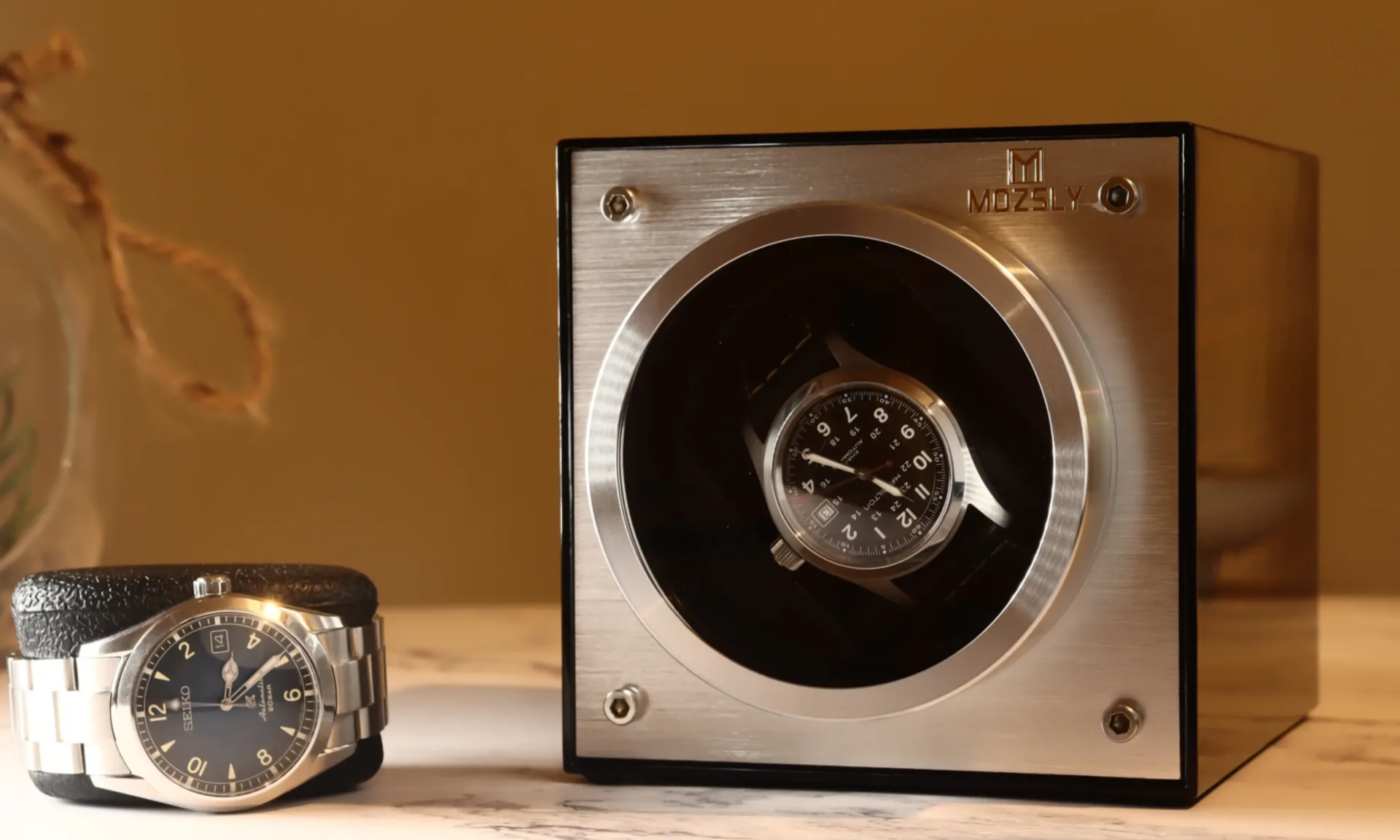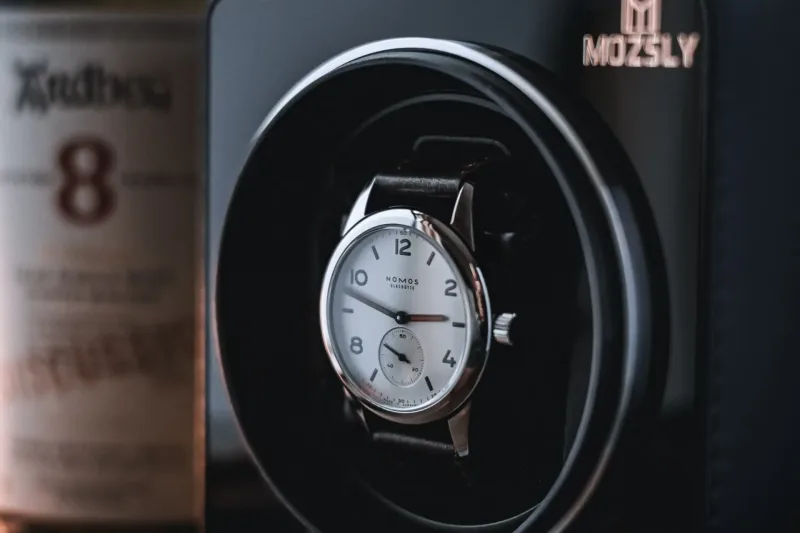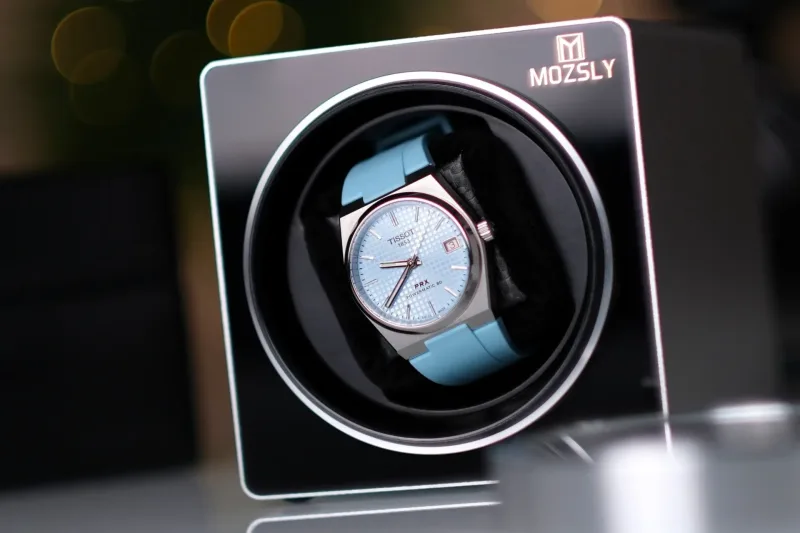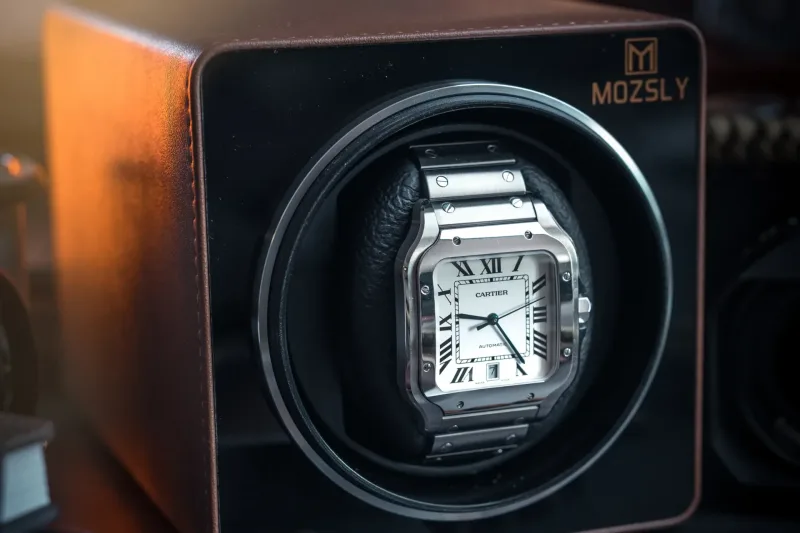Share This Post
Everyday Problems a Watch Winder Fixes
Have you ever done this?
You’re late for an 8 a.m. meeting, grab your $3,000 Omega, and… it still reads 3:17 a.m. from last Tuesday. Now you’re hunched over the crown as your rideshare driver double-parks, glaring.
That panic is why many collectors park their automatic watches in a watch winder—a quiet box that turns the watch just enough to keep its mainspring wound.
“But is an automatic winder really worth it?”
Let’s find out. We’ll start by diving into the real-world benefits—then you can decide whether a watch winder deserves a spot on your dresser.
Four Benefits That Really Matter
Watch winders have many benefits, but these four are definitely the most important.
No More Frozen Watches
If you’ve ever felt that “why now?” frustration of a dead watch, this one’s for you.
A watch winder keeps your automatic running 24/7, so you avoid:
Reset headaches. No more three-minute scrambles to set time, date, and day.
Tardy starts. You reach flights, meetings, and dinner dates on time.
Mental clutter. One less task buzzing around your brain.
Those saved two minutes a day add up to about 12 hours of extra life each year—Netflix, exercise, anything beats fiddling with a crown.
And of course, it’s not just about convenience. Your watch itself feels the difference, too.
Healthier Movements
Inside every automatic a tiny gear coated with very thin oil. When the watch sits still, that oil thickens and drifts (see Watch Times, 2022). A watch winder gives your timepiece gentle, regular turns that:
Keep the oil evenly spread so every gear stays slick.
Reduce friction and long-term wear.
Stretch service intervals from roughly three years to five, saving you $300–$800 per overhaul.
Think of it like idling a car engine for a minute on a cold day—just enough motion to keep things happy.
Speaking of specialized timepieces, if you own a piece with more than just hours and minutes, the next benefit matters even more.
Safer Complications
GMT hands, moon-phase disks, and annual calendars are gorgeous but fussy. Resetting them can take 10–15 minutes, and one wrong push might bend a lever you can’t see.
A watch winder keeps everything in sync, ensuring Monday remains Monday and reduces the risk of damage from constant manual setting.
You’ll save time—you just press a button instead of flipping through a manual.
I’d rather sip coffee than poke tiny pushers at 6 a.m.—how about you?
But beyond all the technical stuff, there’s a simple joy that comes next.
Enjoy (and Show Off) Your Collection
A watch winder doubles as a mini gallery. Slow rotation means:
Dust-free dials that catch the light and make you smile.
Easy selection—you see every watch at a glance, so you actually wear them all.
Guilt-free admiration. You paid for wearable art; it’s fine to enjoy the view.
Mine sits on my desk. When the sun hits the dial each hour, I get a brief “wow” moment… and then back to work.
Alright, so those are the key perks—but how does that little box actually do its job?
How Does a Watch Winder Work?
Think of a watch winder as your wrist’s stand-in.
Tiny motor. A whisper-quiet motor turns a padded drum.
Turns-Per-Day (TPD). How many full spins does the watch get in 24 hours? Most modern movements like 650–900 TPD.
Direction control. Clockwise, counter-clockwise, or both—every caliber is different.
Rest cycles. Good winders spin, pause, spin—mimicking real wrist motion instead of spinning nonstop.
In short, the watch winder “tricks” your timepiece into thinking it’s still on your wrist. Pretty clever for a little box.
Now that you know how a watch winder works, let’s make sure you set it up the right way.
Setting Up Your Watch Winder the Right Way
Don’t worry about setting the winder; it’s a device designed to make things easier for you, not harder. Simply follow these quick steps, and your watch will be running safely and comfortably:
Check the specs. Google “brand + movement + TPD.” Most companies list an ideal range.
Match the TPD. Aim 50–100 TPD above the lower limit. Too low = watch stops. Too high = pointless wear.
Pick the direction. If you’re unsure, choose bi-directional—that covers 99% of modern watches.
Level surface. A tilted box strains both the motor and your rotor.
Listen for noise. Quality watch winders stay under 15 dB—practically a whisper.
Re-check twice a year. Dead batteries and power cuts reset settings. Quick peek, done.
For reference, I use a Mozsly Watch Winder. It adjusts from 650 to 1,950 TPD, changes direction with one button, and is quiet enough to sit on my nightstand without keeping me awake. Zero drama—just smooth rotation.
FAQ—Fast Answers About Watch Winders
Can a watch winder overwind my watch?
No. Modern automatics have a slip clutch that releases tension once fully wound. Stay within the right TPD and you’re safe.
Isn’t manual winding part of the fun?
Totally. If you love that ritual, keep doing it. A watch winder is for convenience, movement health, and display—use it when those perks matter to you.
Are vintage pieces okay on a watch winder?
Pre-1970 watches may lack safety clutches. Ask a watchmaker before you spin Grandpa’s heirloom.
Quick Recap
A good watch winder gives you:
- Daily readiness—grab and go.
- Longer mechanical life—healthy oil, less wear.
- Protection for delicate complications.
- A clean, eye-catching display you’ll actually enjoy.
Now you know how the box works and how to set it up. If those benefits make your life easier, great—let the winder spin. If not, keep winding by hand and enjoy the ritual. Either way, your watches stay the heroes of the story.
Related Post's
Featured Video
Provide an email subscription feature for users to sign up for updates.
Follow the world of watches and cigars for exclusive content!
By subscribing to our newsletter, you will be the first to receive notifications of our latest articles, popular posts and special events.








